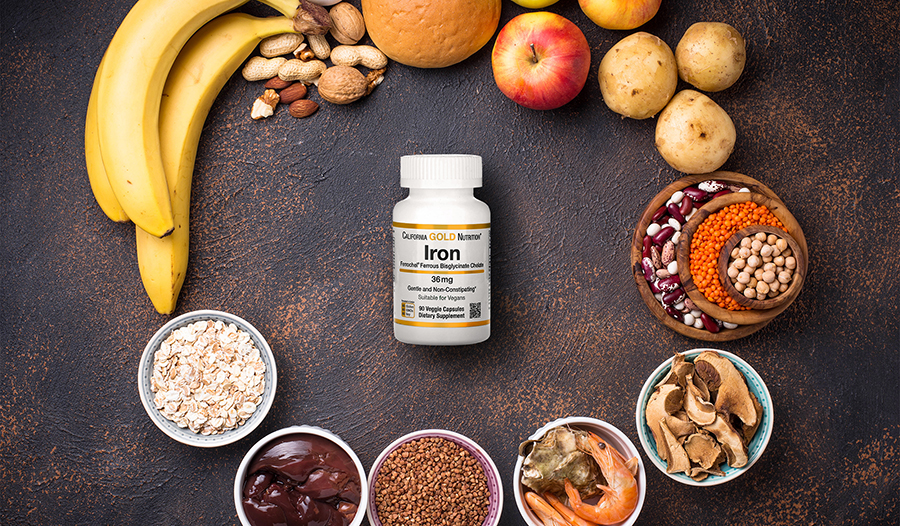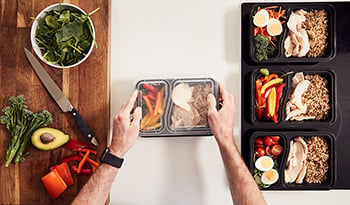Top 5 Foods High In Iron

Originally posted April 2022 / Updated January 2024
What Is Iron?
Iron is a well-known nutrient that plays a central role in the hemoglobin molecule of red blood cells (RBC). Hemoglobin in RBCs transports oxygen from the lungs to the body's tissues and exchanges it with carbon dioxide to take to the lungs. Iron also functions in several key aspects of energy production and metabolism, including the manufacture of DNA, thyroid hormone, enzymes, and some neurotransmitters like dopamine. It is also necessary for proper immune function.[1,2]
Top Iron-Rich Foods
While a number of foods contain iron, here are the top high-iron foods.
1. Red Meat
Red meat (especially beef, lamb, and chicken liver) is the best source of heme iron, the most absorbable form of iron. About 30% of heme iron from red meat is absorbed in our intestines. A 3-oz serving of beef or chicken liver provides about 8 mg of iron while a 6-oz serving of beef provides about 5 mg, and a 6-oz serving of dark-meat poultry provides about 4 mg.
2. Shellfish
Shellfish, especially oysters and mussels, are also a great source of heme iron. Three oysters or 3 oz of mussels provide approximately 6 to 7 mg of iron.
3. Molasses
Molasses—a byproduct of sugar cane processing—is a long-time superfood in the health food industry with an unusually high iron bioavailability. Blackstrap molasses contains 2.3 mg of non-heme iron per tablespoon. It also contains compounds thought to aid the absorption of iron such as sulfur compounds and fructose. One tablespoon can be taken daily to boost iron levels. It can be taken by spoon or used in recipes for gingerbread, baked beans, hot drinks, or meat and vegetable glazes.[12]
4. Legumes
Several legumes (beans) top the list for plant sources of iron. The best sources per ½ cup (cooked or canned) include white or navy beans (4 mg), soybeans or tofu (3 mg), lentils (3), kidney beans (2 mg), and chickpeas (2 mg). Remember that these plant foods contain the non-heme form of iron and compounds known as phytates and polyphenols that inhibit the intestinal absorption of iron. Non-heme iron absorption is not very good compared to heme-iron (5% absorption rate for non-heme vs. 30% for heme-iron).
5. Green Leafy Vegetables
Green leafy vegetables are a nutrient-rich food and a good source of many nutrients, including iron. A ½ cup serving of cooked and drained spinach provides about 3 mg of iron. Other green leafy vegetables supplying similar levels at ½ cup cooked and drained are Swiss chard, beet greens, dandelion greens, and kale.
Types of Iron
There are two forms of dietary iron, "heme" iron and "non-heme" iron. Heme iron is iron bound to hemoglobin and myoglobin (an iron-containing protein found in meat and fish). Non-heme iron is the form found in plant foods and most dietary supplements.[1,11]
Heme-iron is the most efficiently absorbed form of iron and can be as high as 35%.
However, iron absorption depends on many factors, including a person's iron status. The body is designed to absorb more iron when body stores are low and less iron if body levels are adequate. Heme iron uses a special transporter to get the iron from the intestine into the cells where it is needed. In contrast, non-heme iron is often poorly absorbed and challenging for the body to utilize.[1]
Despite the superiority of heme iron, non-heme iron sources are the most popular iron supplements. One reason is that even though heme-iron is better absorbed, it is easy to take a higher quantity of non-heme iron salts so that the net amount of iron absorbed is about equal. In other words, if you take 3 mg of heme iron and 50 mg of non-heme iron, the net absorption for each will be about the same. The Recommended Dietary Allowance (RDA) for iron is 18 mg for women (27 mg during pregnancy) and 8 mg. for men.[1]
Iron Deficiency
Iron deficiency is the most common nutrient deficiency in the world. It is most common in women of childbearing age (especially those with heavy menstrual bleeding) and during pregnancy. Some estimates are that iron deficiency occurs in 35-58% of young, healthy women and is even higher during pregnancy. Women who are vegans or vegetarians or involved in endurance training such as long-distance running, triathlons, or swimming are at a very high risk of iron deficiency, with some studies showing low iron stores in up to 80% of these women.[3-5]
Iron deficiency is also common in infants, older populations, and in people with digestive disorders or inflammatory conditions, vegans, vegetarians, and people who don't eat much meat. Others at risk include those who donate blood frequently and those with a history of digestive tract surgery, such as gastric bypass.[3,6]
Iron deficiency is a spectrum, with early stages being characterized by fatigue, depression, cold hands and feet, decreased physical capacity, impaired immune function, and thinning of the hair. Next is decreased attention span, mental energy, and cognitive function. All of these symptoms can occur before the last stage of iron deficiency: anemia, the lack of oxygen-carrying red blood cells in the body.[7]
Deficiencies in copper, vitamin B12, and folate can cause other kinds of anemia. During an iron deficiency anemia, symptoms generally worsen, particularly those involving the brain.[3,7-9] Correcting an iron deficiency can eliminate all deficiency symptoms.[1,3,10]
Iron is vital to everyone, but children and pregnant women need to consume adequate iron because low levels can contribute to developmental delays, inadequate growth, behavioral issues, and even preterm delivery. Often, supplementation is necessary to meet iron needs. For example, most pregnant women are now routinely prescribed iron supplements as the dramatically increased need for iron during pregnancy is difficult to complete through diet alone.[1]
To check your iron levels, ask your doctor about a blood test known as serum ferritin. The test measures ferritin, a protein that carries iron in your bloodstream. Measuring serum ferritin is a more specific test for measuring iron stores throughout the body than a complete blood count (CBC) or hematocrit. The serum ferritin level should ideally be at least 60 ng/ml. If it is not, increasing dietary iron intake and supplementation is recommended. Keep in mind that iron is a double-edged sword. While too little needs to be avoided, a person must also avoid getting too much iron.[1]
Other Natural Sources of Iron
Take an Iron Supplement
For those who need to boost iron levels, the best supplemental forms of iron are ferric pyrophosphate and ferrous bis-glycinate. These gentle forms do not produce the gastrointestinal side effects of ferrous sulfate and other iron salts (stomach irritation, gas and bloating, constipation, etc.). The dosage recommendation is usually 30 mg twice daily between meals, using these gentler forms to boost iron levels in people with low iron or serum ferritin levels. If this recommendation results in any abdominal discomfort, the recommendation is to take 30 mg with meals three to four times daily.
Cook with a Cast Iron Pan
To increase the iron content of food, you can cook with a cast iron pan. The food will absorb a small amount of iron from the pan. It is not much, but over time, it can add up.
Take Vitamin C
Vitamin C is understood to increase the absorption of non-heme iron in the intestines. Taking a vitamin C supplement or consuming vitamin C-rich foods at the same time as iron supplements can increase effectiveness.
Take Calcium, Magnesium, and Zinc Away from Iron Supplements
Calcium, magnesium, and zinc are popular dietary supplements that compete with iron for absorption and utilization. If you need to boost iron levels in your body, these mineral supplements should be taken as far away as possible from an iron-rich meal or an iron dietary supplement.
Drink Your Coffee or Tea Away from Meals or Iron Supplements
Coffee and black tea contain compounds (polyphenols) that can interfere with iron absorption. If you need iron, enjoying coffee and tea on an empty stomach or away from an iron supplement may be beneficial.
Takeaway
Iron is an essential nutrient, and deficiency is common worldwide. Consuming a well-varied diet with both heme and non-heme iron sources is recommended for ensuring adequate iron intake.
Iron supplements benefit those who need them, but people with adequate iron levels do not need iron supplementation. Excess iron intake may increase oxidative stress, which may worsen inflammation.
If you are a vegan, concerned about your iron status, or experiencing symptoms of iron deficiency, talk to your doctor about getting an iron assessment that includes a serum ferritin test.
References:
- Office of Dietary Supplements - Iron. NIH Office of Dietary Supplements. https://ods.od.nih.gov/factsheets/Iron-HealthProfessional/. Published March 2, 2018. Accessed January 24, 2024.
- Agarwal R. Nonhematological benefits of iron. Am J Nephrol. 2007;27(6):565-71.
- Zimmermann MB, Hurrell RF. Nutritional iron deficiency. Lancet 2007;370:511–520.
- Coad J, Conlon C. Iron deficiency in women: assessment, causes and consequences. Curr Opin Clin Nutr Metab Care. 2011 Nov;14(6):625-34.
- McClung JP. Iron status and the female athlete. J Trace Elem Med Biol. 2012 Jun;26(2-3):124-6.
- Pawlak R, Berger J, Hines I. Iron Status of Vegetarian Adults: A Review of Literature. Am J Lifestyle Med. 2016;12(6):486-498.
- Musallam KM, Taher AT. Iron deficiency beyond erythropoiesis: should we be concerned? Curr Med Res Opin. 2018 Jan;34(1):81-93.
- Pivina L, Semenova Y, Doşa MD, et al. Iron Deficiency, Cognitive Functions, and Neurobehavioral Disorders in Children. J Mol Neurosci. 2019 May;68(1):1-10.
- Sheema UK, Rawekar A. P300, a tool for cognitive assessment in women with iron deficiency anemia: A systematic review. J Family Med Prim Care. 2022 Jun;11(6):2320-2326.
- Lomagno KA, Hu F, Riddell LJ, et al. Increasing iron and zinc in pre-menopausal women and its effects on mood and cognition: a systematic review. Nutrients. 2014 Nov 14;6(11):5117-41.
- Young I, Parker H, Rangan A, et al. Association between haem and non-haem iron intake and serum ferritin in healthy young women. Nutrients. 2018;10(1):81.
- Jain R, Venkatasubramanian P. Sugarcane molasses – a potential dietary supplement in the management of iron deficiency anemia. J Diet Suppl. 2017;14(5):589-598. doi:10.1080/19390211.2016.1269145
DISCLAIMER:This Wellness Hub does not intend to provide diagnosis...














































































 Table of Contents
Table of Contents
















